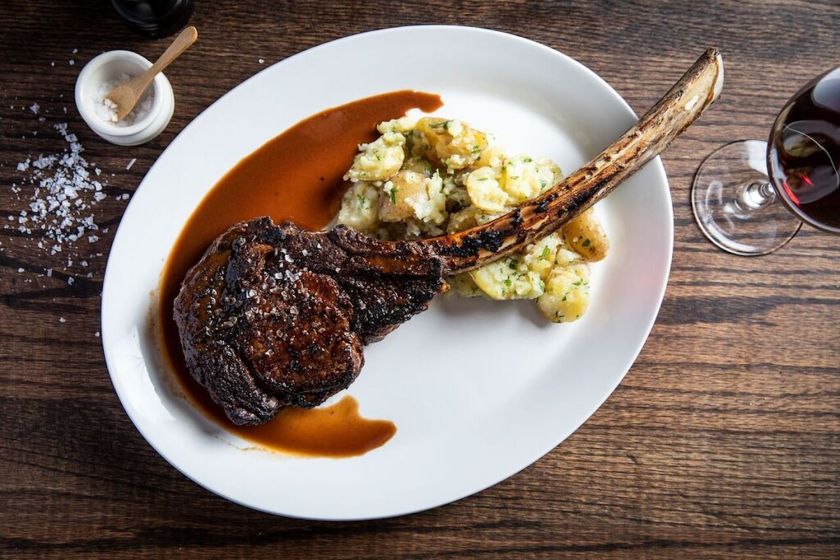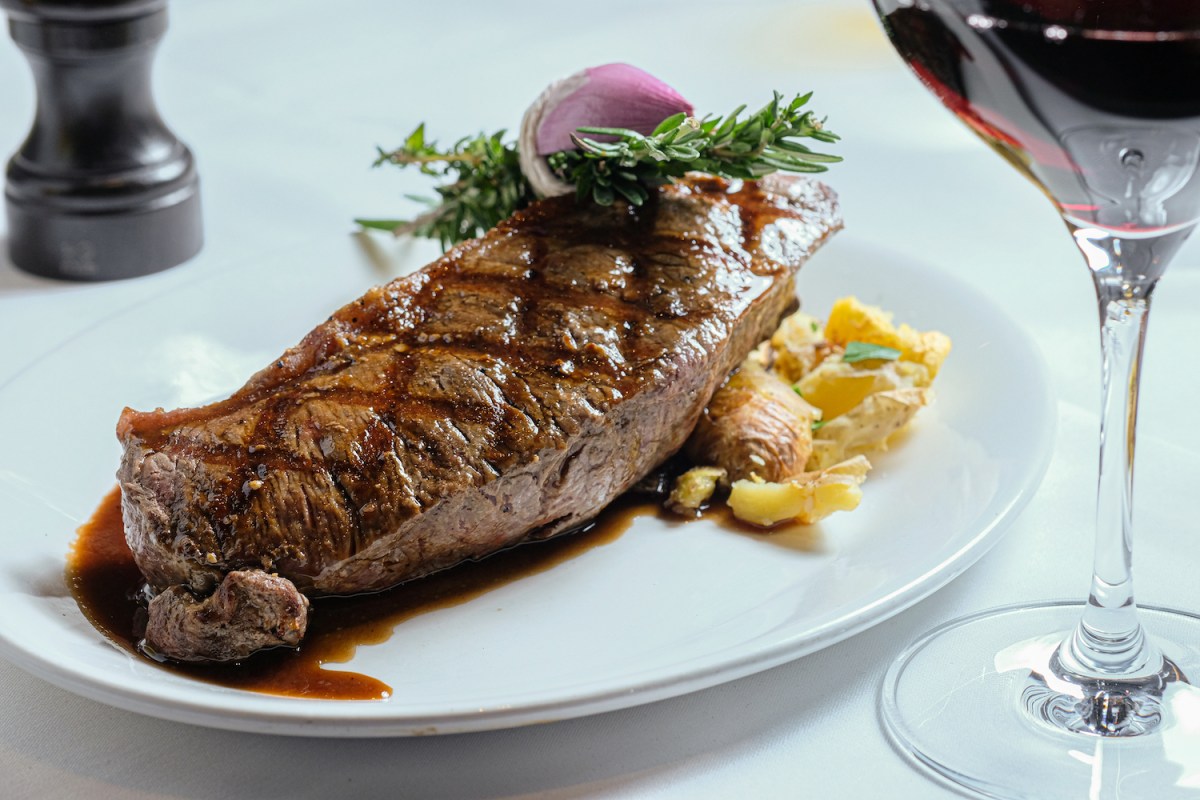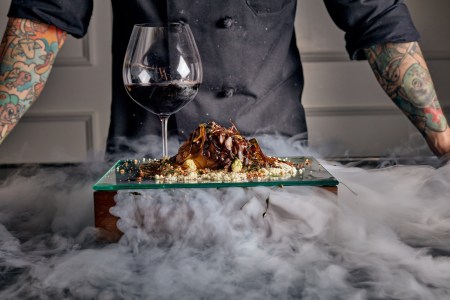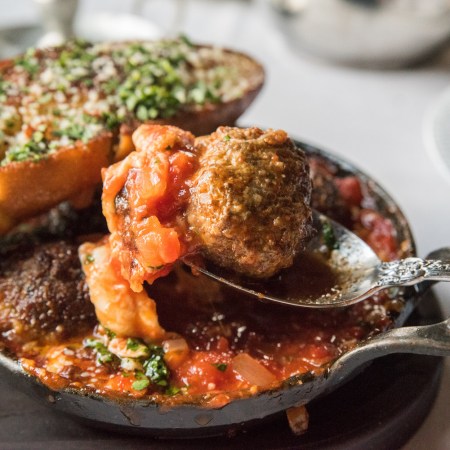If Chicago native Amy Morton’s name rings a bell, it’s because she comes from steak royalty. The daughter of Arnie Morton, founder of Morton’s Steakhouse, Amy is a seasoned restaurant veteran in her own right, whether it’s at The Barn Steakhouse, an ode to her heritage complete with her dad’s bone marrow mashed potatoes, or her new Franco-Moroccan venture, LeTour, with James Beard Award-winning chef Debbie Gold.
But home cooking is a horse of a different color. When it comes to making perfect steak dinners at home, Morton reaps much of her cooking chops from her dad — and a whole lot of entertaining know-how from her mother-in-law.
“Even though I grew up in the restaurant business, it took watching the way my mother-in-law did her parties to realize: I don’t have to be a slave to the kitchen,” Morton tells InsideHook. “When you have a party at home, you want to be part of the gathering.”
If you want to host a steakhouse-level dinner from the comfort of your own home, here are her tips on doing it right, from shopping for the perfect steaks to service.

1. Know Your Provider
Whether you’re sourcing your meat directly from a farmer, from your local butcher shop or from a mail-order meat seller, one of the most important details Morton gleaned from her dad was choosing a quality provider.
“Simply knowing the people we buy our beef from — or any product for that matter,” she says. “Knowing the person and trusting the people we buy it from, and then educating ourselves the best we can through the cuts we personally like, the style, the chew, the flavor…I think that’s the most important thing, especially for somebody at home.”
Aside from top-notch quality, one major bonus of sourcing directly from a knowledgeable source is gaining access to their wealth of knowledge. Don’t be afraid to ask your butcher questions.
“’Has this been wet-aged? Has it been aged at all? And how long?’” Morton suggests as a few options. “People don’t realize that if something’s not dry-aged, it doesn’t mean, necessarily, that it’s not aged. So that’s a good question when people are purchasing.”
Whether you’re asking about the products themselves or the pros’ favorite ways to prepare them, chances are you’ll come away far more knowledgeable than if you’d just grabbed a steak at the grocery store.
2. Choose the Right Cut
It’s no secret that each cut boasts its own characteristics in terms of flavor and texture, but zeroing in on the one you want to serve your party isn’t quite the same task as ordering your fave off a menu. For Morton, it comes down not only to the tastes of your guests, but what you feel comfortable cooking. And price is certainly a deciding factor.
According to Morton, the three most popular cuts out there couldn’t be more different. Filet, also known as beef tenderloin, is by far the most expensive, and she also notes it’s the most popular. What it lacks in fat and flavor it more than makes up for in tender, melt-in-your-mouth texture.
“And,” she notes, “it looks lovely on the plate.”
While beef tenderloin certainly can be cooked as individual steaks, it’s perhaps most impressive as a whole roast, which also makes it easier to prepare for a crowd.
“It’s just managing one piece,” she says of this cut, which can then be sliced and plated quickly and easily. “I think it’s an easier choice…if somebody has the pocketbook for it.”
New York strip, meanwhile, is “that classic steak cut that we know,” says Morton. “It’s got what we know as the traditional bite for steak. When we bite into a New York, that’s what most people expect a steak to be.”
With a toothsome texture and way more flavor than a filet, it’s also far more affordable. When it comes to serving it, too, it’s “easy peasy,” she says. “You figure everybody’s going to get their own.”
And then, of course, there’s the ribeye — the cut Morton terms “the chef’s cut.”
“A chef goes to a restaurant, they’re always ordering the ribeye,” she says. The richest and fattiest of the three, it’s perhaps not the most natural of choices for a dinner party, she muses, perhaps because “it’s misunderstood.”
“In our culture,” she says, “even though we’re eating steak, we’re trying to cut down on fat. And it’s definitely the fattiest.”
Chicago’s 8 Best Hotel Restaurants
The city’s most spectacular restaurants come with an option for an overnight stay3. Don’t Neglect the “Lesser” Cuts
Of course, these three cuts are just the beginning.
“There are so many cuts that most people have never, ever heard of that can be a fraction of the price and can be perfect for any dinner party,” explains Morton.
Her favorite has long been skirt steak, a cut from the plate that’s richly flavored but has some chew to it. While skirt steak has recently spiked in popularity — and thus in price — the insider cuts to watch these days are the baseball cut (a rounded steak from the top sirloin) or the Manhattan cut (a cut of New York strip sized for a smaller portion). The only downside of serving either one is that they resemble filet at first glance, and given their lower price point, it’s no surprise they don’t boast the same tenderness.
“It could be, ‘Oh, this isn’t as good as the last filet I had,’” she says of guests’ reactions. “So I think you need to set it up as, ‘Oh my god, I got this new cut of beef.’”
While neither is widely available in supermarkets, she says you should be able to track down either one at a good butcher.
4. Let the Beef Speak for Itself
They don’t call them steak sauce and steak seasoning for nothing, but Morton has always been “an ultra purist” when it comes to her beef.
“I’m a salt and pepper girl,” she says. “I don’t put anything else on my steak, and we don’t put anything else on it in the restaurant.”
It makes sense, especially if you’re shelling out for a top-quality product.
“I personally want to find the very best beef I can find and let it sing on its own,” she says. “Start with the best product — and I’ll add ‘that you can afford.’ And then let that product speak for itself. That’s what I learned from my dad.”

5. Feel Free to Nerd Out — Or Not
From dry-aging to reverse-searing to sous-vide, the world of at-home steak cooking has experienced an explosion, of late, of new techniques to test and try. And while experimenting with these avant-garde methods is certainly fun, Morton says, there’s no need to feel like you must jump on the latest steak trend.
“I think it’s as much for the thrill and the excitement for the at-home cook as it is for enhancing the dinner party,” she says. “Somebody who’s into smoking, they want to sit there and take time with it. They want a 12-hour project, you know? They want to check the temperature.”
If all you want is to cook a tasty steak for your friends, however, feel free to use simple, time-tested techniques: A classic sear never steered anyone wrong. If your original product is good, you’ll be golden — as long as you obey Arnie Morton’s number one rule: “Don’t overcook the steak. Don’t overcook the steak. Don’t overcook the steak.”
6. Post-Its Are Your Best Friend
Much of what makes a good dinner party great happens in advance, behind the scenes. Morton gleaned one such tip from her mom, who would take time long before the guests arrived to choose her serveware and plan which dish would go in which bowl. She would place a slip of paper into each, Morton recalls, so that she wouldn’t forget which dish went where.
“She had it all laid out, and she had serving utensils, so all the thinking is done in advance,” she says, noting that not only does this tip cut down on stress if the host is frazzled, but it also makes it easy for guests and partners to lend a hand.
7. Don’t Stress Out About Hot Meat
A sit-down party should be an elegant dance, not a frenzied attempt to get everything on the table at once. Morton recommends getting the appetizers on the table before even putting the beef on to cook, taking the time to linger at the table before disappearing into the kitchen to finish off the main event.
The reason this works, of course, is that steak should never be served ripping hot out of the pan. A steak should be pulled out of the pan just under the temperature you’re looking for and allowed to carryover cook to completion. This means you’re looking at a solid 10 to 15 minutes of resting time, depending on the cut, before slicing and serving.
“All those juices that have gone to the center have those moments to be reabsorbed into the rest of the cut, which tenderizes it, and moisturizes it, and fills it with flavor that we lose when we pull it off a sear, throw it onto a plate and cut it,” she says. (Here’s a good chart you can use to help you get the hang of it).
If that still feels like too much hassle to deal with during your party, Morton notes that steak can also be delicious served cold.
“My parents had an annual Christmas party, and filet mignon sandwiches were always on the menu,” she recalls. “And whether you sliced them to order on the buffet, whether you slice the meat up beautifully and people can make their own sandwiches, whether you already have them pre-made…they’re just as good room-temperature or hot.”
8. Consider Your Sides
While a great steak can certainly stand alone, classic steakhouse sides are classics for a reason. When designing her own menus, Morton keeps seasonality and color front of mind, all the while hewing to that tried-and-true pairing of steak, potato and veg.
“I think a little succotash works great, and it’s super colorful, with asparagus, red peppers, corn, depending on the season,” she says. “I think creamed corn is amazing, if you’re somebody who likes to go to the farmer’s market and take your corn off the cob, rather than using it and just freezing it.”
At her restaurant, she toys with tradition by creaming not spinach but kale and Swiss chard, for a slightly more modern spin.
9. Don’t Neglect Dessert
Many steakhouse dessert menus read like a list of gut bombs, from carrot cake to cheesecake to chocolate torte. And while Morton likes these options, she tends to skew simpler, especially at home.
“I think I would just do a simple berry,” she says, noting that while she’s not a fan of whipped cream, seasonal raspberries and homemade zabaglione “would be the crowning dish of the night.”
Every Thursday, our resident experts see to it that you’re up to date on the latest from the world of drinks. Trend reports, bottle reviews, cocktail recipes and more. Sign up for THE SPILL now.

























